Page 33 of 104
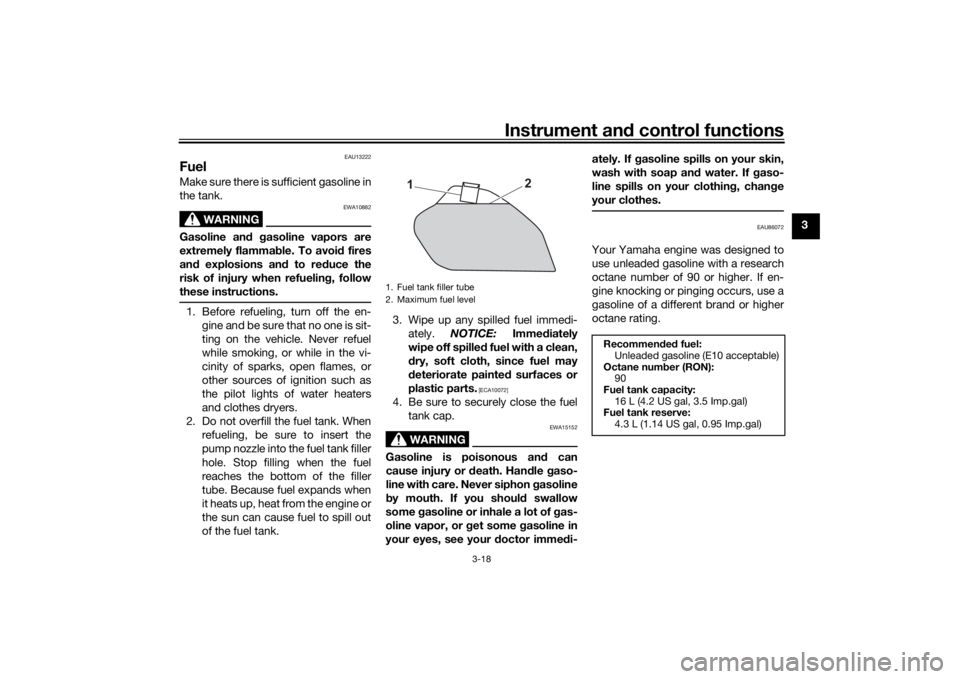
Instrument and control functions
3-18
3
EAU13222
FuelMake sure there is sufficient gasoline in
the tank.
WARNING
EWA10882
Gasoline an d gasoline vapors are
extremely flammab le. To avoid fires
an d explosions an d to re duce the
risk of injury when refuelin g, follow
these instructions.1. Before refueling, turn off the en- gine and be sure that no one is sit-
ting on the vehicle. Never refuel
while smoking, or while in the vi-
cinity of sparks, open flames, or
other sources of ignition such as
the pilot lights of water heaters
and clothes dryers.
2. Do not overfill the fuel tank. When refueling, be sure to insert the
pump nozzle into the fuel tank filler
hole. Stop filling when the fuel
reaches the bottom of the filler
tube. Because fuel expands when
it heats up, heat from the engine or
the sun can cause fuel to spill out
of the fuel tank. 3. Wipe up any spilled fuel immedi-
ately. NOTICE: Immediately
wipe off spille d fuel with a clean,
d ry, soft cloth, since fuel may
d eteriorate painte d surfaces or
plastic parts.
[ECA10072]
4. Be sure to securely close the fuel tank cap.
WARNING
EWA15152
Gasoline is poisonous an d can
cause injury or d eath. Handle gaso-
line with care. Never siphon gasoline
b y mouth. If you shoul d swallow
some gasoline or inhale a lot of gas-
oline vapor, or g et some gasoline in
your eyes, see your doctor imme di- ately. If g
asoline spills on your skin,
wash with soap an d water. If gaso-
line spills on your clothin g, chan ge
your clothes.
EAU86072
Your Yamaha engine was designed to
use unleaded gasoline with a research
octane number of 90 or higher. If en-
gine knocking or pinging occurs, use a
gasoline of a different brand or higher
octane rating.
1. Fuel tank filler tube
2. Maximum fuel level
2
1
Recommen ded fuel:
Unleaded gasoline (E10 acceptable)
Octane num ber (RON):
90
Fuel tank capacity: 16 L (4.2 US gal, 3.5 Imp.gal)
Fuel tank reserve:
4.3 L (1.14 US gal, 0.95 Imp.gal)
UBEHE0E0.book Page 18 Tuesday, December 8, 2020 6:57 PM
Page 34 of 104

Instrument and control functions
3-19
3
TIP This mark identifies the recom-
mended fuel for this vehicle as
specified by European regulation
(EN228).
Confirm the gasoline pump nozzle
has the same fuel identification
mark.Gasohol
There are two types of gasohol: gaso-
hol containing ethanol and that con-
taining methanol. Gasohol containing
ethanol can be used if the ethanol con-
tent does not exceed 10% (E10). Gas-
ohol containing methanol is not
recommended by Yamaha because it
can cause damage to the fuel system
or vehicle performance problems.
NOTICE
ECA11401
Use only unlea ded g asoline. The use
of lea ded g asoline will cause severe
d amag e to internal en gine parts,
such as the valves an d piston rin gs,
as well as to the exhaust system.
EAU80201
Fuel tank overflow hoseBefore operating the vehicle: Check the fuel tank overflow hose
connection.
Check the fuel tank overflow hose
for cracks or damage, and replace
it if necessary.
Make sure that the end of the fuel
tank overflow hose is not blocked,
and clean it if necessary.
Make sure that the end of the fuel
tank overflow hose is positioned
as shown.TIPSee page 6-10 for canister information.
E5
E10
1. Canister breather hose
1
UBEHE0E0.book Page 19 Tuesday, December 8, 2020 6:57 PM
Page 35 of 104
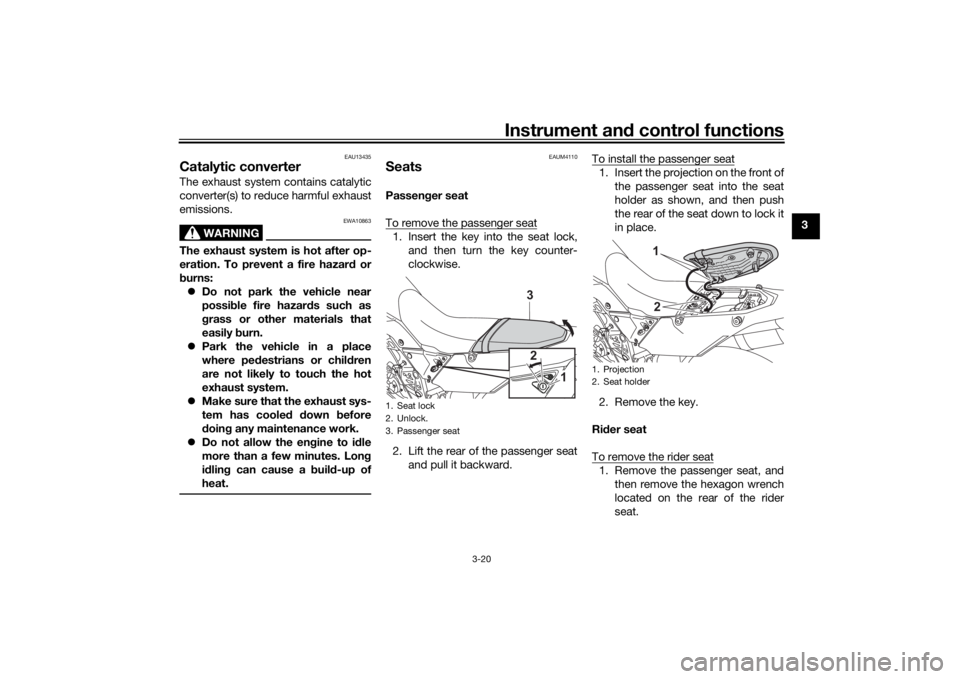
Instrument and control functions
3-20
3
EAU13435
Catalytic converterThe exhaust system contains catalytic
converter(s) to reduce harmful exhaust
emissions.
WARNING
EWA10863
The exhaust system is hot after op-
eration. To prevent a fire hazar d or
b urns:
Do not park the vehicle near
possi ble fire hazar ds such as
g rass or other materials that
easily burn.
Park the vehicle in a place
where pe destrians or chil dren
are not likely to touch the hot
exhaust system.
Make sure that the exhaust sys-
tem has coole d down before
d oin g any maintenance work.
Do not allow the en gine to i dle
more than a few minutes. Lon g
i d lin g can cause a buil d-up of
heat.
EAUM4110
SeatsPassen ger seat
To remove the passenger seat1. Insert the key into the seat lock, and then turn the key counter-
clockwise.
2. Lift the rear of the passenger seat and pull it backward. To install the passenger seat
1. Insert the projection on the front of
the passenger seat into the seat
holder as shown, and then push
the rear of the seat down to lock it
in place.
2. Remove the key.
Ri der seat
To remove the rider seat1. Remove the passenger seat, and then remove the hexagon wrench
located on the rear of the rider
seat.
1. Seat lock
2. Unlock.
3. Passenger seat
2
13
1. Projection
2. Seat holder
12
UBEHE0E0.book Page 20 Tuesday, December 8, 2020 6:57 PM
Page 36 of 104

Instrument and control functions
3-21
3
2. Remove the bolts with the hexa-gon wrench.
3. Lift the rear of the rider seat and pull it backward. To install the rider seat
1. Insert the projection on the front of
the rider seat into the seat holder
as shown, and then place the seat
in the original position.
2. Install the bolts with the hexagon wrench.
3. Insert the hexagon wrench back into its holder on the rider seat.
4. Install the passenger seat.TIPMake sure that the seats are properly
secured before riding.
EAU90940
A djustin g the hea dlig ht beamsThe headlight beam can be adjusted to
raise or lower the height of the head-
light beams. It may be necessary to ad-
just the headlight beams to increase
visibility and help prevent blinding on-
coming drivers when carrying more or
less load than usual. Obey local laws
and regulations concerning headlight
adjustment.
If headlights require adjustment, con-
sult a Yamaha dealer.
1. Hexagon wrench
1. Bolt
1
1
1. Projection
2. Slot1 2
UBEHE0E0.book Page 21 Tuesday, December 8, 2020 6:57 PM
Page 37 of 104
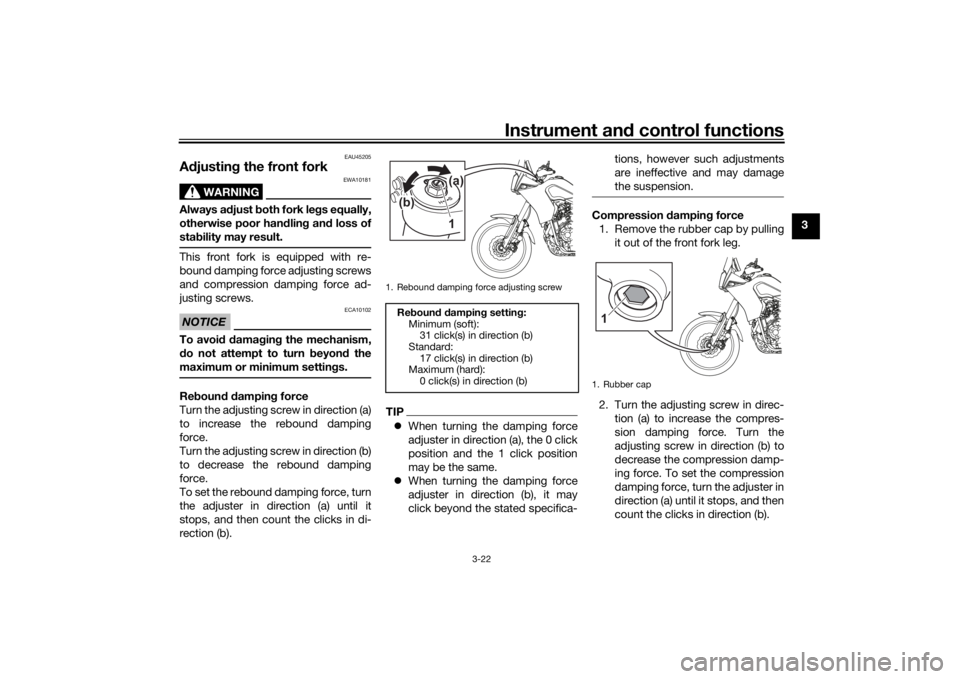
Instrument and control functions
3-22
3
EAU45205
A djustin g the front fork
WARNING
EWA10181
Always a djust both fork le gs equally,
otherwise poor han dlin g an d loss of
sta bility may result.This front fork is equipped with re-
bound damping force adjusting screws
and compression damping force ad-
justing screws.NOTICE
ECA10102
To avoi d d amag ing the mechanism,
d o not attempt to turn b eyond the
maximum or minimum settin gs.Re boun d d ampin g force
Turn the adjusting screw in direction (a)
to increase the rebound damping
force.
Turn the adjusting screw in direction (b)
to decrease the rebound damping
force.
To set the rebound damping force, turn
the adjuster in direction (a) until it
stops, and then count the clicks in di-
rection (b).
TIP When turning the damping force
adjuster in direction (a), the 0 click
position and the 1 click position
may be the same.
When turning the damping force
adjuster in direction (b), it may
click beyond the stated specifica- tions, however such adjustments
are ineffective and may damage
the suspension.
Compression
dampin g force
1. Remove the rubber cap by pulling it out of the front fork leg.
2. Turn the adjusting screw in direc- tion (a) to increase the compres-
sion damping force. Turn the
adjusting screw in direction (b) to
decrease the compression damp-
ing force. To set the compression
damping force, turn the adjuster in
direction (a) until it stops, and then
count the clicks in direction (b).
1. Rebound damping force adjusting screw
Reboun d d ampin g settin g:
Minimum (soft): 31 click(s) in direction (b)
Standard: 17 click(s) in direction (b)
Maximum (hard):
0 click(s) in direction (b)
1
(b) (a)
1. Rubber cap1
UBEHE0E0.book Page 22 Tuesday, December 8, 2020 6:57 PM
Page 38 of 104
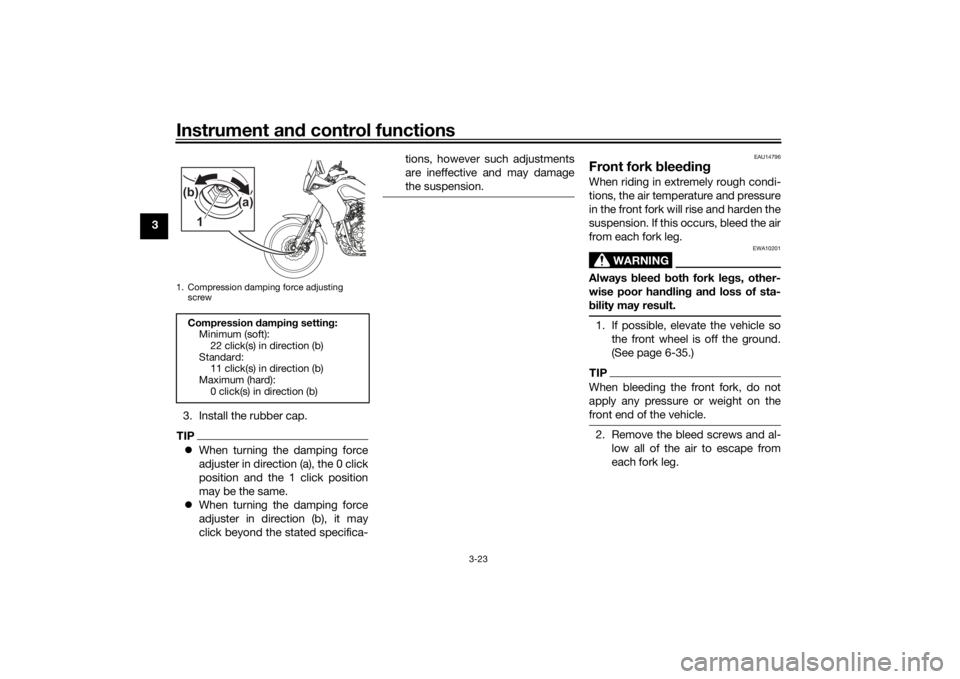
Instrument and control functions
3-23
3
3. Install the rubber cap.
TIPWhen turning the damping force
adjuster in direction (a), the 0 click
position and the 1 click position
may be the same.
When turning the damping force
adjuster in direction (b), it may
click beyond the stated specifica- tions, however such adjustments
are ineffective and may damage
the suspension.
EAU14796
Front fork
blee din gWhen riding in extremely rough condi-
tions, the air temperature and pressure
in the front fork will rise and harden the
suspension. If this occurs, bleed the air
from each fork leg.
WARNING
EWA10201
Always blee d b oth fork le gs, other-
wise poor han dlin g an d loss of sta-
b ility may result.1. If possible, elevate the vehicle so
the front wheel is off the ground.
(See page 6-35.)TIPWhen bleeding the front fork, do not
apply any pressure or weight on the
front end of the vehicle.2. Remove the bleed screws and al-low all of the air to escape from
each fork leg.
1. Compression damping force adjusting screwCompression dampin g settin g:
Minimum (soft): 22 click(s) in direction (b)
Standard: 11 click(s) in direction (b)
Maximum (hard):
0 click(s) in direction (b)1 (a)
(b)
UBEHE0E0.book Page 23 Tuesday, December 8, 2020 6:57 PM
Page 39 of 104
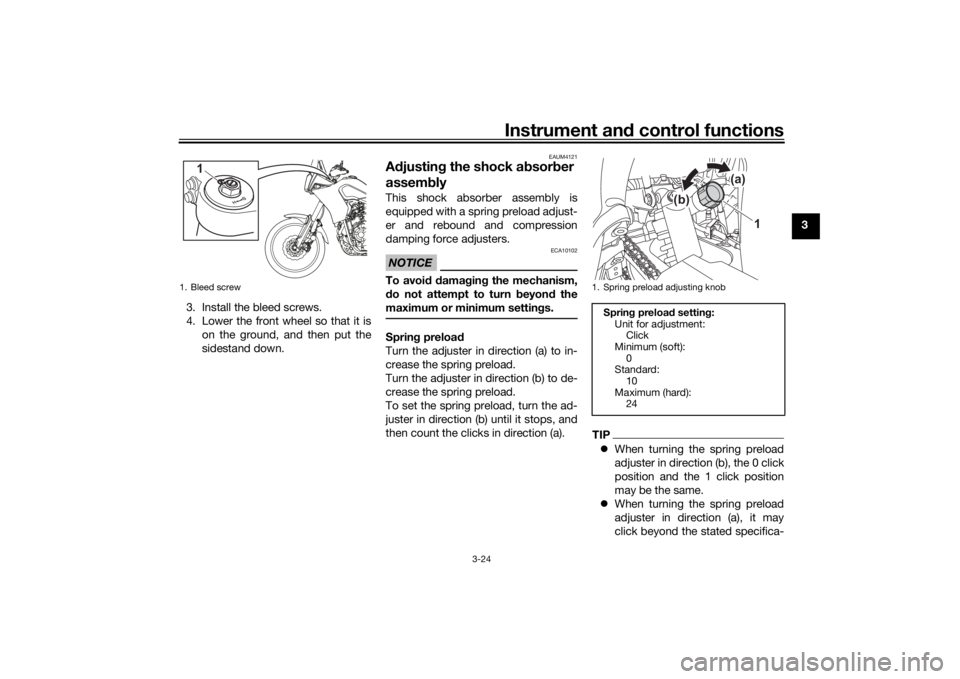
Instrument and control functions
3-24
3
3. Install the bleed screws.
4. Lower the front wheel so that it is on the ground, and then put the
sidestand down.
EAUM4121
Adjustin g the shock a bsor ber
assem blyThis shock absorber assembly is
equipped with a spring preload adjust-
er and rebound and compression
damping force adjusters.NOTICE
ECA10102
To avoi d d amag ing the mechanism,
d o not attempt to turn b eyond the
maximum or minimum settin gs.Sprin g preloa d
Turn the adjuster in direction (a) to in-
crease the spring preload.
Turn the adjuster in direction (b) to de-
crease the spring preload.
To set the spring preload, turn the ad-
juster in direction (b) until it stops, and
then count the clicks in direction (a).
TIP When turning the spring preload
adjuster in direction (b), the 0 click
position and the 1 click position
may be the same.
When turning the spring preload
adjuster in direction (a), it may
click beyond the stated specifica-
1. Bleed screw
1
1. Spring preload adjusting knob
Sprin g preloa d settin g:
Unit for adjustment: Click
Minimum (soft): 0
Standard:
10
Maximum (hard): 24
1
(b) (a)
UBEHE0E0.book Page 24 Tuesday, December 8, 2020 6:57 PM
Page 40 of 104
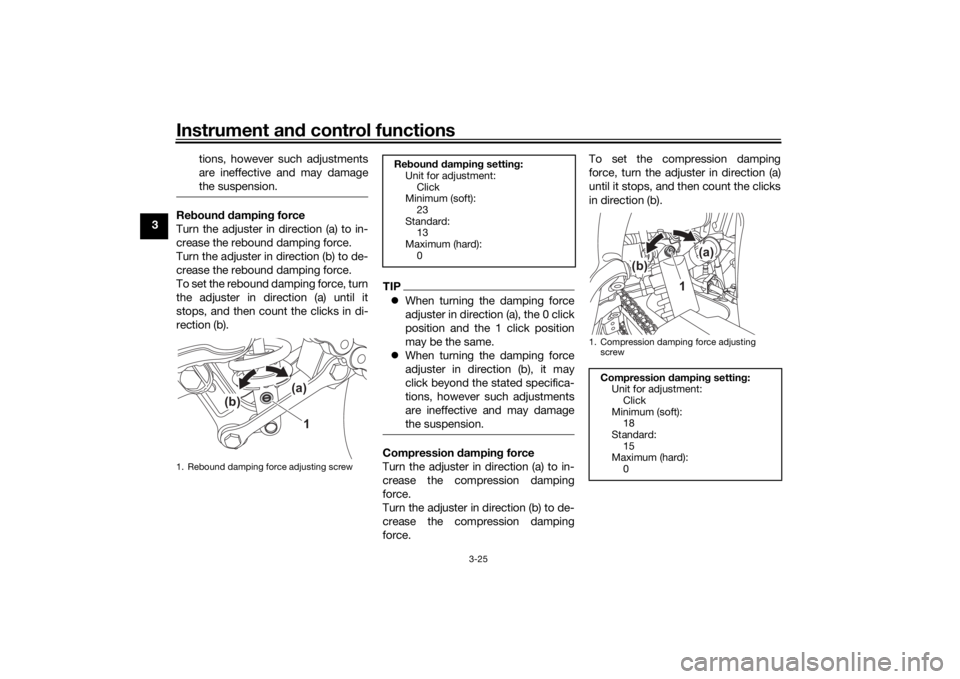
Instrument and control functions
3-25
3 tions, however such adjustments
are ineffective and may damage
the suspension.
Re
boun d d ampin g force
Turn the adjuster in direction (a) to in-
crease the rebound damping force.
Turn the adjuster in direction (b) to de-
crease the rebound damping force.
To set the rebound damping force, turn
the adjuster in direction (a) until it
stops, and then count the clicks in di-
rection (b).
TIP When turning the damping force
adjuster in direction (a), the 0 click
position and the 1 click position
may be the same.
When turning the damping force
adjuster in direction (b), it may
click beyond the stated specifica-
tions, however such adjustments
are ineffective and may damage
the suspension.Compression dampin g force
Turn the adjuster in direction (a) to in-
crease the compression damping
force.
Turn the adjuster in direction (b) to de-
crease the compression damping
force. To set the compression damping
force, turn the adjuster in direction (a)
until it stops, and then count the clicks
in direction (b).
1. Rebound damping force adjusting screw
1
(b)
(a)
Re
boun d d ampin g setting :
Unit for adjustment:
Click
Minimum (soft):
23
Standard: 13
Maximum (hard): 0
1. Compression damping force adjusting
screwCompression dampin g settin g:
Unit for adjustment: Click
Minimum (soft): 18
Standard:
15
Maximum (hard): 0
1
(b) (a)
UBEHE0E0.book Page 25 Tuesday, December 8, 2020 6:57 PM
 1
1 2
2 3
3 4
4 5
5 6
6 7
7 8
8 9
9 10
10 11
11 12
12 13
13 14
14 15
15 16
16 17
17 18
18 19
19 20
20 21
21 22
22 23
23 24
24 25
25 26
26 27
27 28
28 29
29 30
30 31
31 32
32 33
33 34
34 35
35 36
36 37
37 38
38 39
39 40
40 41
41 42
42 43
43 44
44 45
45 46
46 47
47 48
48 49
49 50
50 51
51 52
52 53
53 54
54 55
55 56
56 57
57 58
58 59
59 60
60 61
61 62
62 63
63 64
64 65
65 66
66 67
67 68
68 69
69 70
70 71
71 72
72 73
73 74
74 75
75 76
76 77
77 78
78 79
79 80
80 81
81 82
82 83
83 84
84 85
85 86
86 87
87 88
88 89
89 90
90 91
91 92
92 93
93 94
94 95
95 96
96 97
97 98
98 99
99 100
100 101
101 102
102 103
103






